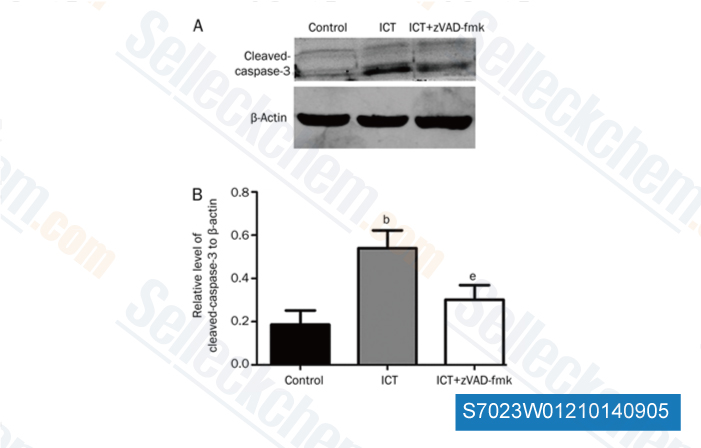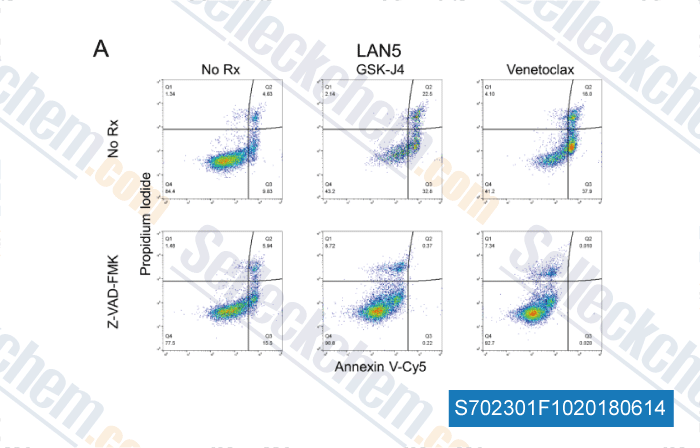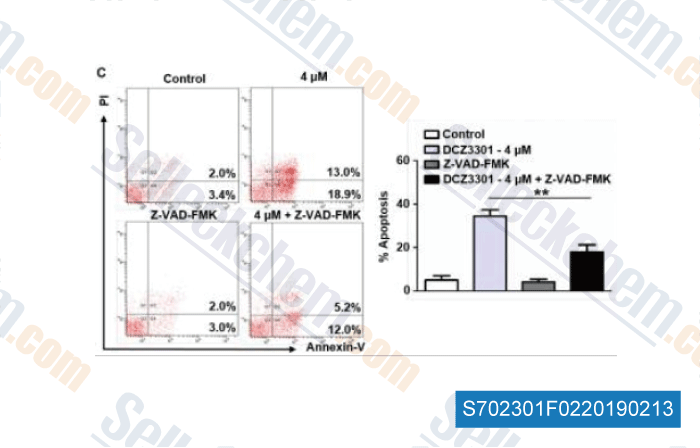|
Toll Free: (877) 796-6397 -- USA and Canada only -- |
Fax: +1-832-582-8590 Orders: +1-832-582-8158 |
Tech Support: +1-832-582-8158 Ext:3 Please provide your Order Number in the email. |
Technical Data
| Formula | C22H30FN3O7 |
||||||||||||||
| Molecular Weight | 467.49 | CAS No. | 187389-52-2 | ||||||||||||
| Solubility (25°C)* | In vitro | DMSO | 94 mg/mL (201.07 mM) | ||||||||||||
| Ethanol | 7 mg/mL (14.97 mM) | ||||||||||||||
| Water | Insoluble | ||||||||||||||
| In vivo (Add solvents to the product individually and in order) |
|
||||||||||||||
|
* <1 mg/ml means slightly soluble or insoluble. * Please note that Selleck tests the solubility of all compounds in-house, and the actual solubility may differ slightly from published values. This is normal and is due to slight batch-to-batch variations. * Room temperature shipping (Stability testing shows this product can be shipped without any cooling measures.) |
|||||||||||||||
Preparing Stock Solutions
Biological Activity
| Description | Z-VAD-FMK (Z-VAD(OMe)-FMK) is a cell-permeable, irreversible pan-caspase inhibitor, blocks all features of apoptosis in THP.1 and Jurkat T-cells. | |
|---|---|---|
| Targets |
|
|
| In vitro | Z-VAD-FMK (10 μM) inhibits apoptosis in THP.1 cells. Z-VAD-FMK (10 μM) inhibits activation of PARP protease activity in control THP.1 cell lysates. Z-VAD-FMK (10 μM) inhibits the processing of CPP32 in intact THP.1 and Jurkat cells. [1] Z-VAD-FMK (50 μM) cotreatment abolishes the apoptotic morphology of camptothecin-treated HL60 cells. Z-VAD-FMK (50 μM) blocks camptothecin-induced DNA fragmentation in HL60 cells. [2] Z-VAD-FMK (50 μM) inhibits cell death following dSMN dsRNA-induced apoptosis in S2 cells. Z-VAD-FMK (50 μM) increases the percentage of transfected cells surviving from 26% to 63% in S2 cells. [3] Z-VAD-FMK (> 100 μM) enhances TNFα-induced neutrophil apoptosis, lower concentrations (1-30 μM) completely blocks TNFα-stimulated apoptosis in human neutrophils. [4] Z-VAD-FMK (10 mM) inhibits apoptosis in anterior stromal keratocytes. Z-VAD-FMK (10 mM) inhibits apoptosis in anterior stromal keratocytes detected with the TUNEL assay. [5] |
|
| In vivo | In vivo Z-VAD-FMK administration has been shown previously to be nontoxic and to prevent apoptosis in animal models. Intraperitoneal HK-GBS injection leads to preterm delivery, and pretreatment with Z-VAD-FMK delays preterm delivery in mice. In OVA-sensitized mice,treatment of z-VAD-fmk inhibits allergen-induced leukocyte infiltration. Systemic injection of the pan-caspase inhibitor z-VAD-fmk immediately before OVA challenge reduced inflammatory cell accumulation, mucus hypersecretion, and Th2 cytokine release in OVA-sensitized/challenged mice. Treatment with z-VAD-fmk blocked terminal differentiation of lens epithelial cells and keratinocytes, the differentiation of monocytes into macrophages, and the differentiation of erythroid progenitors. z-VAD-fmk attenuated allergen-induced airway inflammation and hyperreactivity. Treatment with z-VAD-fmk in vivo also prevented subsequent T cell activation ex vivo[7]. |
|
| Features | A key compound for apoptosis studies. |
Protocol (from reference)
| Cell Assay: |
|
|---|---|
| Animal Study: |
|
References
Customer Product Validation

-
Data from [Acta Pharmacol Sin, 2014, 35(4):531-9]

-
Data from [Data independently produced by , , Science, 2018, 10(441), doi: 10.1126/scitranslmed.aao4680]

-
Data from [Data independently produced by , , Cancer Res, 2017, 77(4):926-936]

-
Data from [Data independently produced by , , Theranostics, 2017, 7(15):3690-3699]
Selleck's Z-VAD-FMK has been cited by 1214 publications
| LINE-1 ORF1p Mimics Viral Innate Immune Evasion Mechanisms in Pancreatic Ductal Adenocarcinoma [ Cancer Discov, 2025, 10.1158/2159-8290.CD-24-1317] | PubMed: 39919290 |
| Targeting pancreatic cancer glutamine dependency confers vulnerability to GPX4-dependent ferroptosis [ Cell Rep Med, 2025, 6(2):101928] | PubMed: 39879992 |
| Epigenetic regulation of HOXA2 expression affects tumor progression and predicts breast cancer patient survival [ Cell Death Differ, 2025, 10.1038/s41418-024-01430-2] | PubMed: 39833374 |
| SLC25A1 and ACLY maintain cytosolic acetyl-CoA and regulate ferroptosis susceptibility via FSP1 acetylation [ EMBO J, 2025, 10.1038/s44318-025-00369-5] | PubMed: 39881208 |
| LP-118 is a novel B-cell lymphoma 2 / extra-large inhibitor that demonstrates efficacy in models of venetoclaxresistant chronic lymphocytic leukemia [ Haematologica, 2025, 110(1):78-91] | PubMed: 39113656 |
| RIPK1 is required for ZBP1-driven necroptosis in human cells [ PLoS Biol, 2025, 23(2):e3002845] | PubMed: 39982916 |
| A Targeted Nanotoxin Inhibits Colorectal Cancer Growth Through Local Tumor Pyroptosis and Eosinophil Infiltration and Degranulation [ Int J Nanomedicine, 2025, 20:2445-2460] | PubMed: 40034221 |
| Promoting the transition from pyroptosis to apoptosis in endothelial cells: a novel approach to alleviate methylglyoxal-induced vascular damage [ J Transl Med, 2025, 23(1):170] | PubMed: 39930472 |
| Suppression of Dad1 induces cardiomyocyte death by weakening cell adhesion [ Am J Physiol Cell Physiol, 2025, 328(1):C95-C106] | PubMed: 39611549 |
| Bafilomycin A1 induces colon cancer cell death through impairment of the endolysosome system dependent on iron [ Sci Rep, 2025, 15(1):5148] | PubMed: 39934167 |
RETURN POLICY
Selleck Chemical’s Unconditional Return Policy ensures a smooth online shopping experience for our customers. If you are in any way unsatisfied with your purchase, you may return any item(s) within 7 days of receiving it. In the event of product quality issues, either protocol related or product related problems, you may return any item(s) within 365 days from the original purchase date. Please follow the instructions below when returning products.
SHIPPING AND STORAGE
Selleck products are transported at room temperature. If you receive the product at room temperature, please rest assured, the Selleck Quality Inspection Department has conducted experiments to verify that the normal temperature placement of one month will not affect the biological activity of powder products. After collecting, please store the product according to the requirements described in the datasheet. Most Selleck products are stable under the recommended conditions.
NOT FOR HUMAN, VETERINARY DIAGNOSTIC OR THERAPEUTIC USE.
